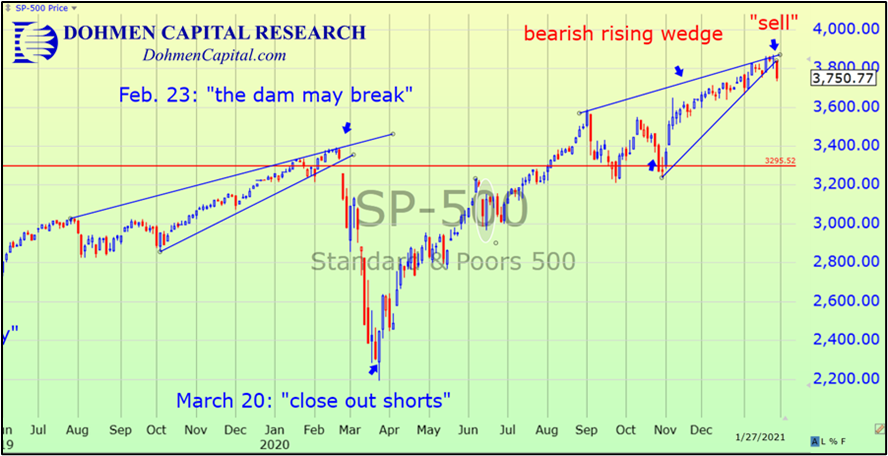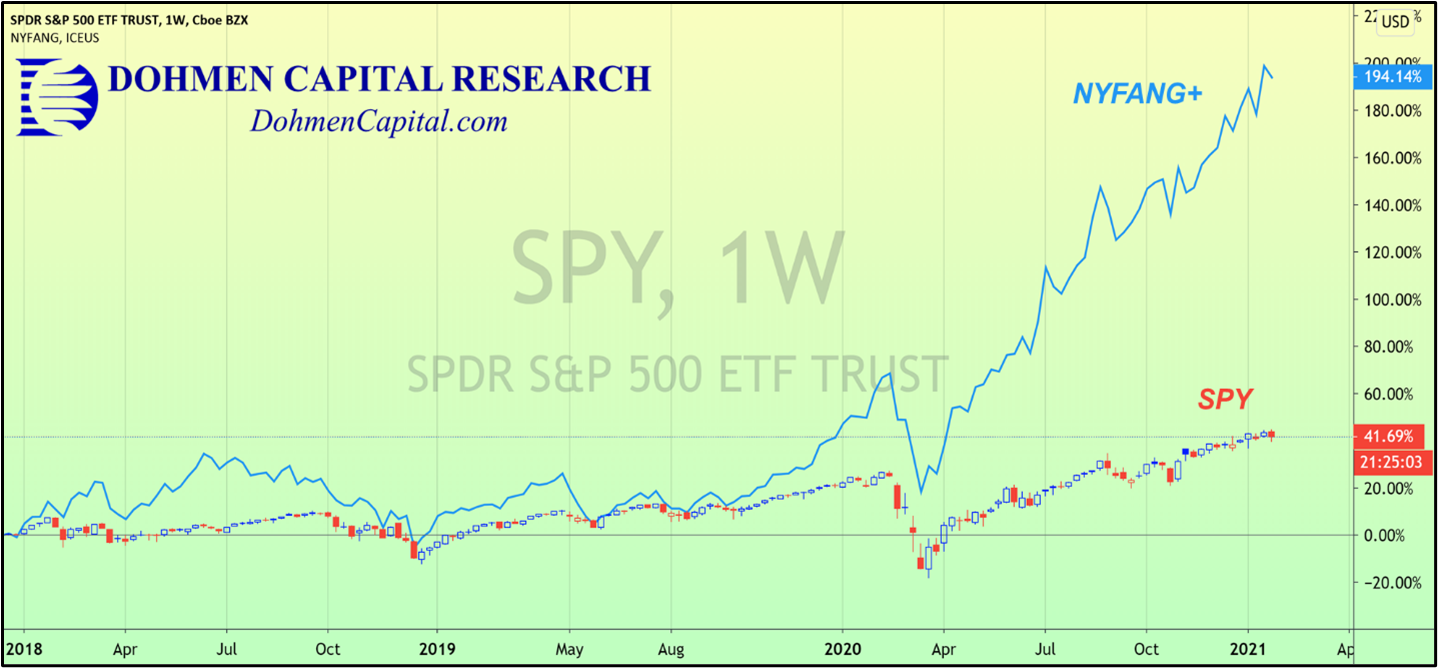A New Strategy For Outperforming The Markets
This week confirmed once again everything we have written over the past year: forget valuations and other metrics. Determine the planned ‘agenda’.
Yes, markets are manipulated, and now more so than ever. That means that our methods of technical analysis at Dohmen Capital Research, which measure factors like money flows, are more important than ever. For example, the chart formations give us a great picture of the trend of buying versus selling pressure.
Our chart below shows two “rising wedges”. These are important negative formations, but you have to wait for the downside breakout. See how that triggered our sell signal on February 23rd last year, which perfectly timed the crash that started the next day.
Now we have another rising wedge and a downside breakout. It doesn’t guarantee another crash, but it tells us it is time for action.
The day after we issued the signal in our trading services to “raise cash,” the markets opened on big down-gaps and plunged, with the Dow down about 735 points intraday. It was another bullseye for us and our valued subscribers.

In our Wellington Letter, which will be released at the end of January, we will give our complete analysis of what lies ahead.
It is always important for investors to have a plan. Don’t act on emotions or what you hear in the media. They always tell you to “hold for the long-term.” That’s about the worst advice you can get.
They will tell you “no one can time the markets.” We have shown over 45 years that it is possible to time the market, by calling all significant declines over that time. Look again at our calls over the past year.
If a bear market is ahead, does it make more sense to stay invested all the way through the valley? Or is it better to sell high and then have cash to eventually invest near the low when the masses finally capitulate?
The answer seems obvious, but most investors don’t follow the right course.
There are more serious problems in our future. These include the viability of the financial system when there is an avalanche of sell orders and no buys.
Thomas Peterffy, the founder of Interactive Brokers, said today that recent losses in the options markets on wrong bets have been between $10 and $15 billion. Although there are equivalent gains on the other side, the losers may not be able to meet the margin calls.
As we wrote recently, for individuals, all personal assets are collateral for margin calls, even houses. We would bet that 99% of traders are not aware of that risk.
There will be heavy casualties from the extreme volatility we saw this year. When even major brokerage firms had computer failures and customers could not place trades, buys or sells, for hours, there is liability.
It makes you wonder what will happen during a serious crash. In fact, today a hedge fund veteran was on CNBC predicting that whenever the crash happens, it will be monumental. That is, of course, our view as well. Brokers will not be prepared. Are you prepared for a time you can’t sell?
Is the current level of stocks justified, even if there is a reopening of the economy? The CEO of Southwest Air, one of the best-managed airlines, said today that revenues would have to double from present values for them to get to cash breakeven.
Imagine how much the larger, more poorly managed airlines are suffering. It could be that the last decade of good profits for the airlines industry is behind us. The industry was unprofitable for most of its existence until about the last two decades or so.
Imagine, if you would had bought into the industry when the first airliner flew, you would have made no money.
According to the S&P Indices Versus Active (SPIVA) scorecard, an astonishing 78% of large-cap fund managers underperformed the S&P 500 index over the past 5 years.
A big 82% even failed to beat the S&P over the last decade.
And over 87% didn’t beat the index over the last 15 years.
Those are surprising numbers, and may make you want to rush out and just by an S&P 500 index fund and forget about actively trading the markets.
Why is that? Are these fund managers dumb or is there an important reason for their underperformance, such as protecting their clients?
The debate of index investing vs. active investing has gone on for decades. One reason for the underperformance of active investing is that the index is always 100% invested. Thus, if a money manager gets cautious, and either increases cash positions or goes into defensive sectors, he will underperform during a bull market.
Another very important factor from the past 10 years is the high-frequency trading (HFT) industry, which is about to manipulate the indices by pushing a few high capitalization stocks up, controlling the performance of an entire index like the S&P 500.
These HFT outfits, with their super-fast computers, can place over 90,000 trades (trades, not shares) per second. Gains per trade may be a few dollars, but with 90,000 trades per second, it adds up.
HFT firms don’t only buy - they can also sell short. Since 1933 there had been an “uptick rule” which required an uptick from the prior trade before a short sale could be activated. That was a great impediment for HFT. Therefore, magically the “uptick rule” disappeared without publicity in 2007. Now HFT firms can manipulate short-term stock moves at will.
They seem to love the biggest and most liquid stocks. The NYFANG+ index, made up of 10 very big-cap stocks, shows this. A portfolio of only these stocks would have vastly outperformed the S&P 500 index, especially over the past few years, as you can see on the chart below.

The S&P 500 gained about 76% from its March 23rd, 2020 low to January 20th, 2021, while the NYFANG+ gained nearly 176%.
That leads to the question: why not just buy the 10 stocks in the NYFANG+? It is worth considering. But then you must find a good warning system to get you out somewhere near the top.
It is important to note that the NYFANG+ is a static index. It is not an ETF you can buy.
The best money manager may be able to outperform during a bear market when he can get defensive. The problem: he often doesn’t act, as he is caught up in the euphoria near an important top.
Or, he goes back into the market too early thinking it’s just a buying opportunity. Most are not very good with technical analysis.
For outperformance, it means that an investor must be ready to be an “active” investor rather than “buy and hold forever.”
It is important to time the sectors instead of the major market indices. Sometimes, sectors underperform the market for a long time. You want to avoid those. We track sectors’ performance relative to a major index.
Furthermore, an investor must have patience to let his strategy work for longer than six weeks or six months. That doesn’t mean holding a specific stock but instead keeping to a specific strategy. Investing, as opposed to trading, is a journey.
You can trade short-term with part of your portfolio if desired, but a big portion should be devoted to “active” investing. That means positions held for possibly several months, but not “forever.”
Bottom Line: Contrary to popular opinion, stock or index performance has little to do with most economic fundamentals touted by economists. Availability of money is the major driving factor, not the many economic statistics like employment, GDP, trade balance, etc.
The best time to buy stocks is when these economic statistics look the worst. That’s when the smart, successful investors buy, not when the economy is very strong. The latter often causes the Fed to tighten money, and that is the primary factor that causes bear markets because the availability of money shrinks. Hard to believe? Check it out!
It has worked for us and our valued subscribers at Dohmen Capital Research for 45 years, helping us avoid all the major market declines, both short- and ...
more



To do well at active trading one must make correct choices in a timely manner, That, in turn requires skill, knowledge, and insight, which certainly are not evenly distributed among society. So for many folks the buy and hold is quite reasonable.